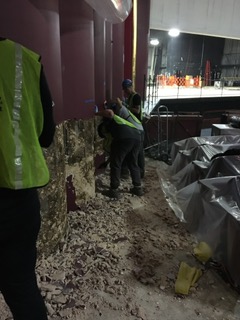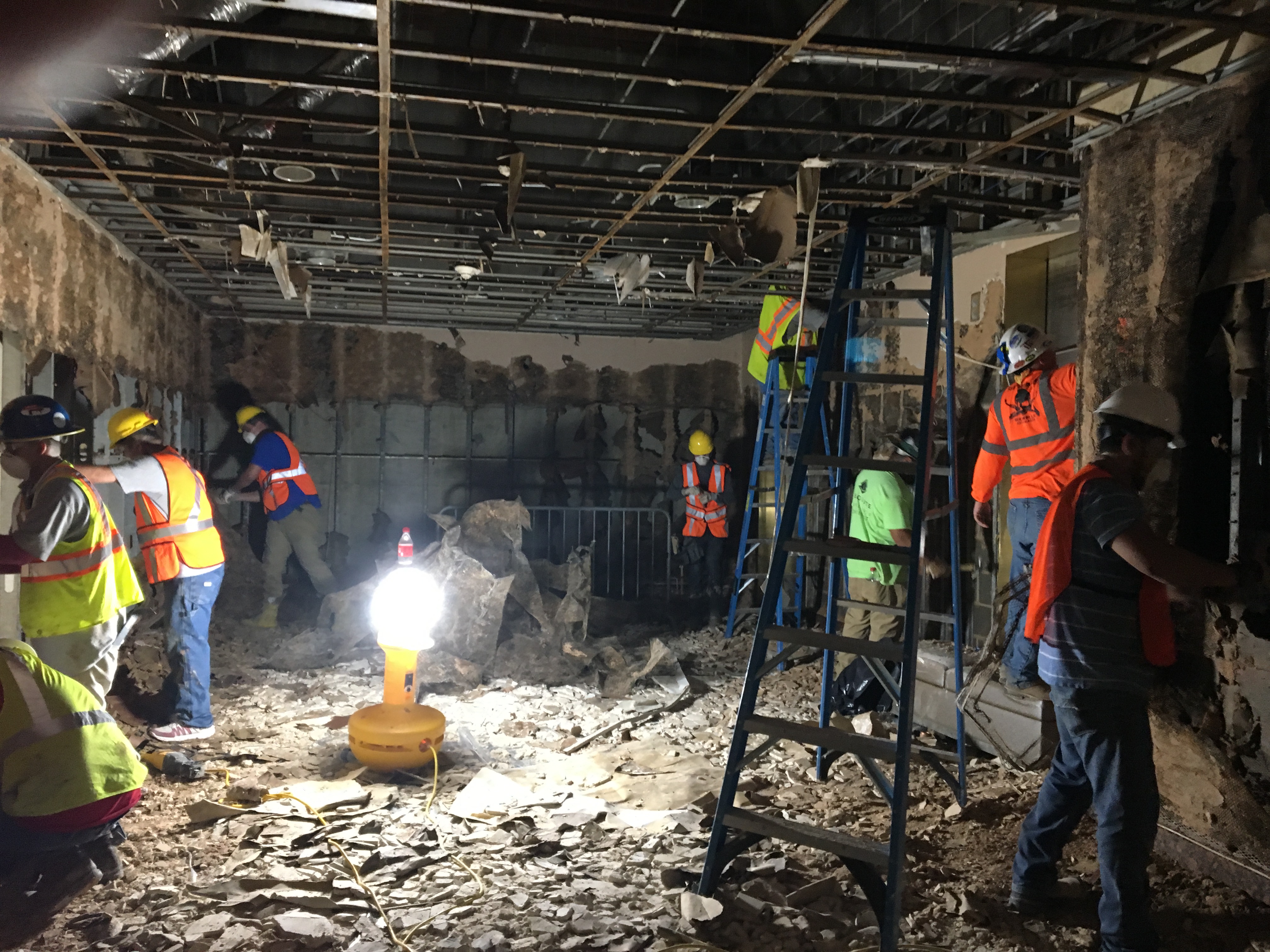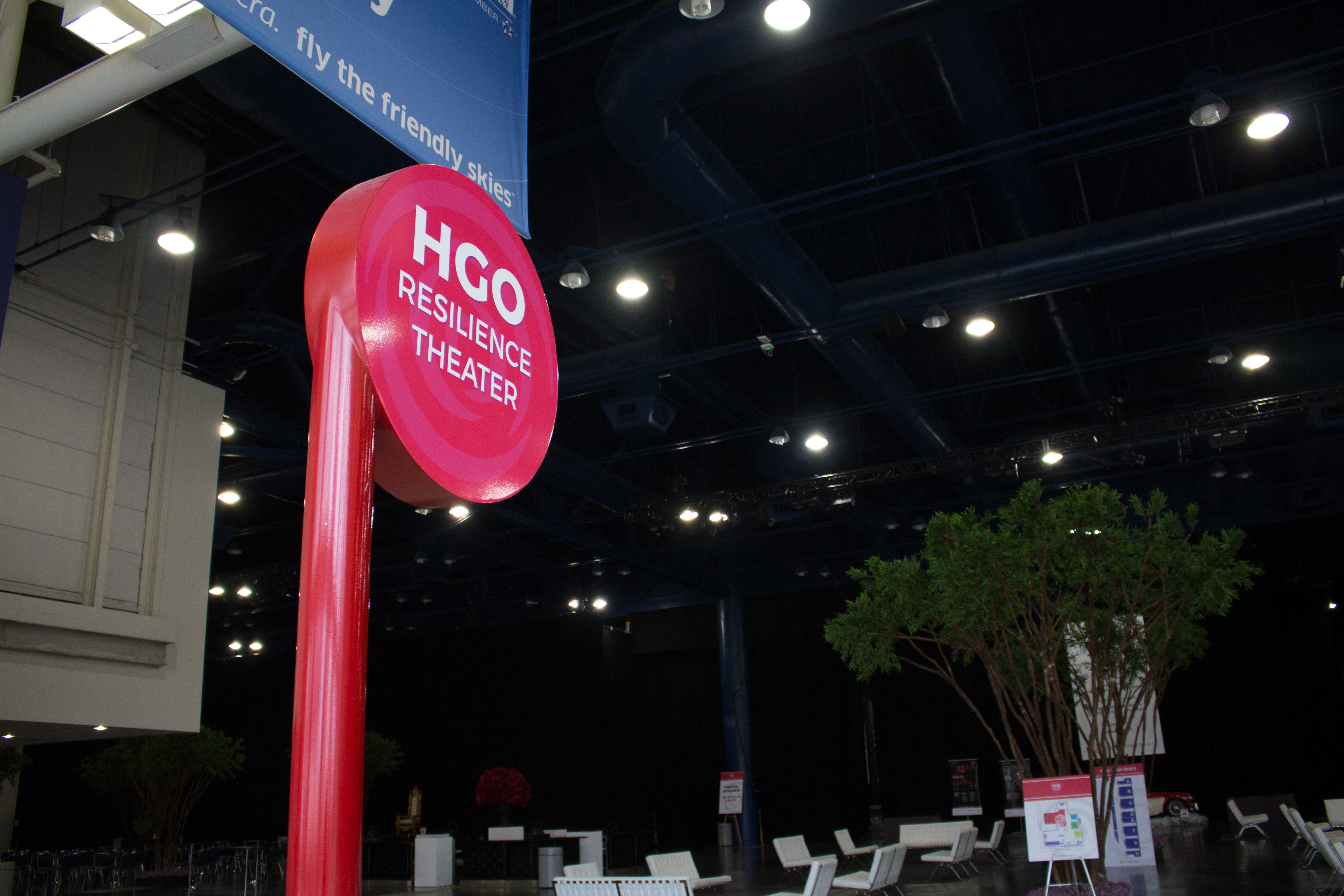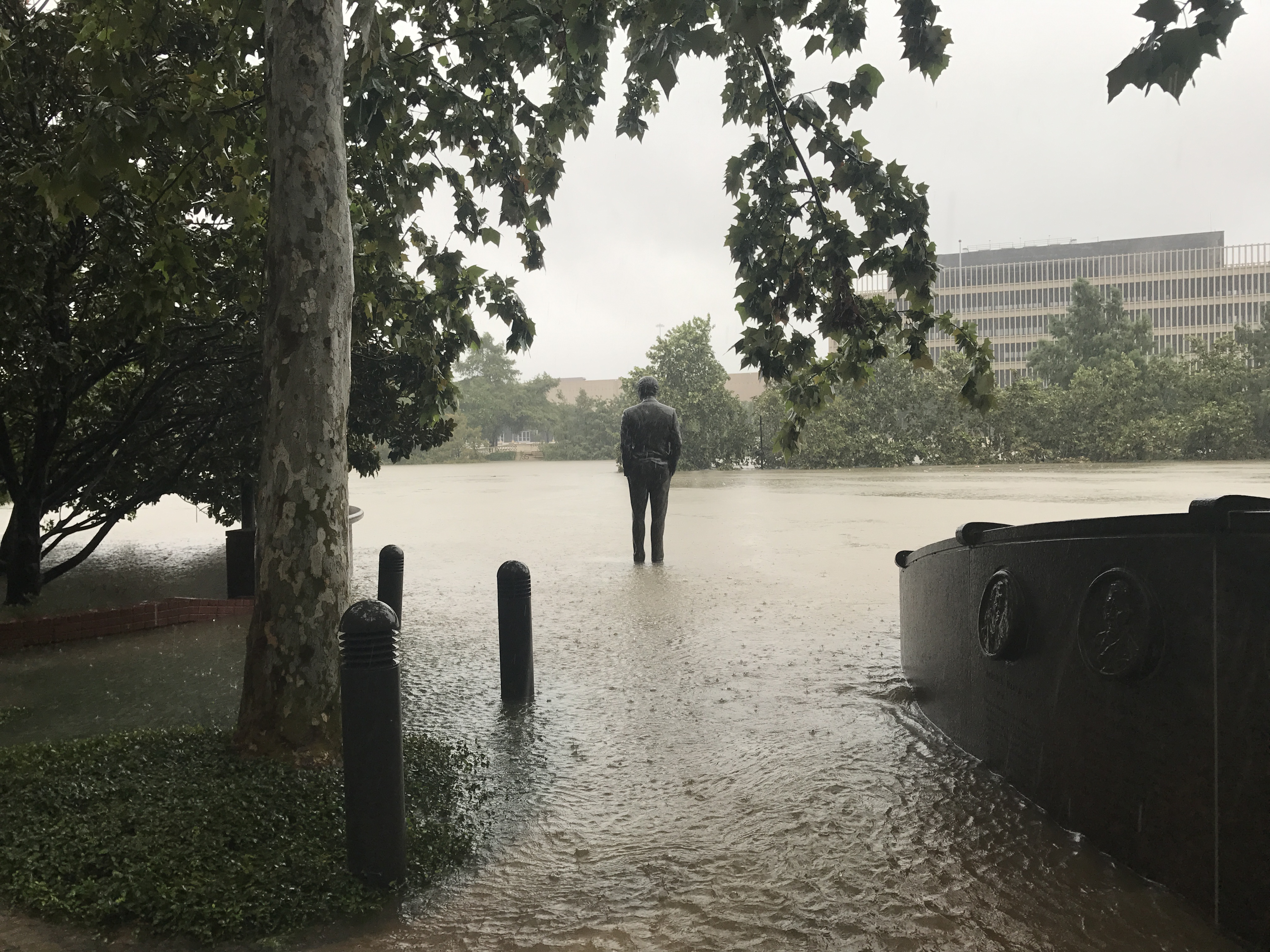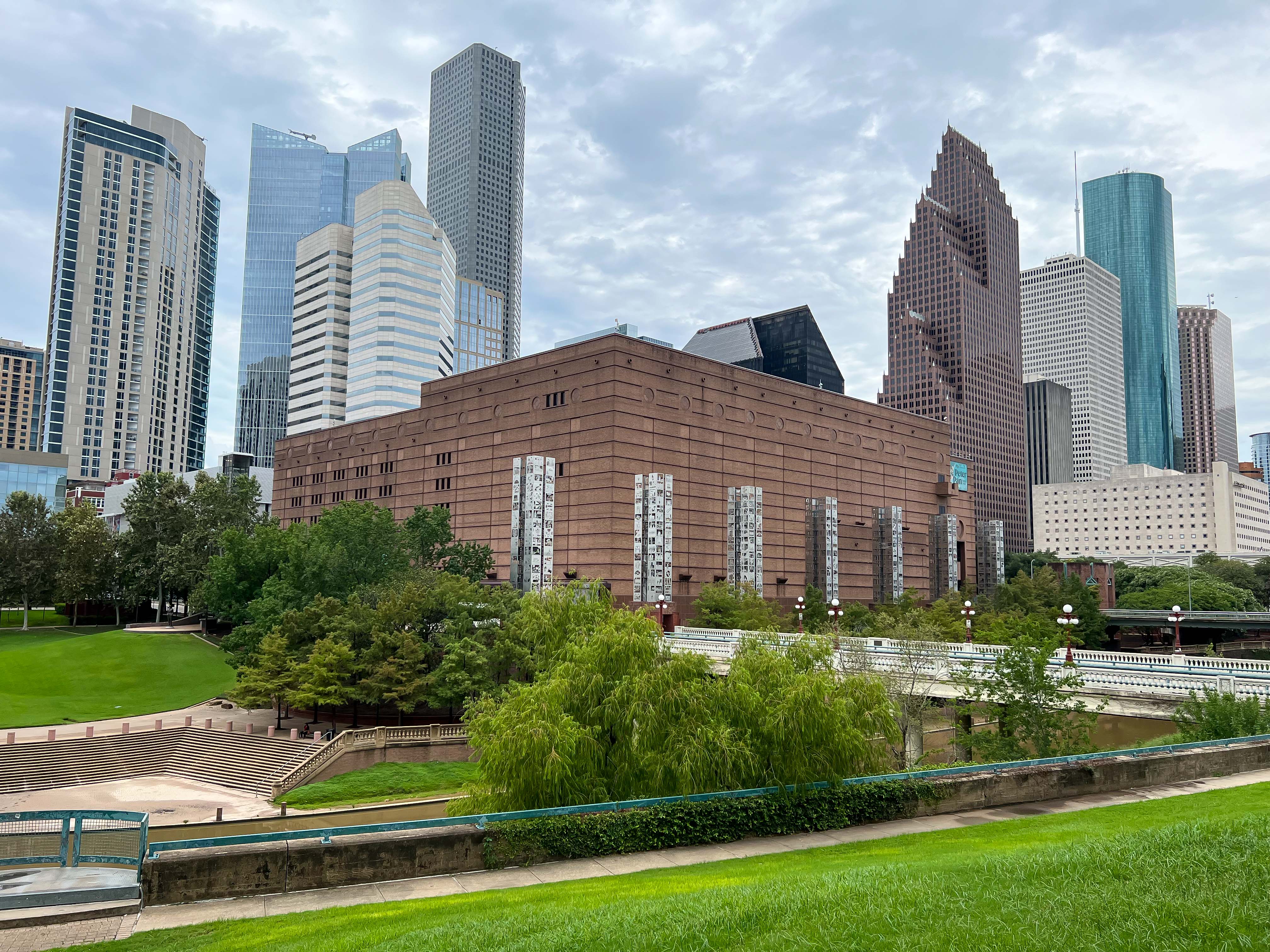UNFORGETTABLE
In the months prior to Hurricane Harvey, we thought HGO had faced its biggest challenge—Wagner’s Ring of the Nibelungen—then it started raining.
This year’s opening night production of La traviata is new, despite being seen in the Resilience Theater only five years ago. Read on, please.
Before the COVID-19 pandemic reordered our lives, a little more than five years ago, on August 17, 2017, Houstonians first heard of a Tropical Storm developing in the Caribbean. Its name was the benign and homey-sounding Harvey.
HGO’s then-Managing Director Perryn Leech and I went through every potential scenario to save the opera season that was by then little more than a month away: we looked at over 30 venues around Houston, including a potential performance tent to be erected in a parking lot. In the midst of all of that, we were shown the large center auditorium in the George R. Brown Convention Center, and the staff began measuring and drawing various plans. Walking through one of the larger exhibition halls on our way out, a lightbulb lit above Perryn’s head. “This could work better,” he said.
The building of the Resilience Theater in Exhibition Hall 3 was entirely Perryn’s brainchild. He went into crisis mode to get the theater ready to open the season on October 20, inspiring the staff with his own energy to get it all done. Since all of our rehearsal spaces and offices were, though not flooded, off limits because of the flood, these also had to be relocated, all within the span of a few days. We held almost daily emergency staff meetings in my apartment building. Starbucks all over town became HGO offices because they had free wi-fi. Incredibly, not a single onstage rehearsal or performance that season was canceled or missed, including Arin Arbus’s new production of Verdi’s La traviata, conducted by Eun Sun Kim in her American debut, the same production that opens this 2022-23 season—well, not quite the same.
Though, we knew in 2017 that this would be no ordinary Traviata. It is impossible to accurately describe the chaotic flurry of phone calls (this was before we all got on Zoom) that ensued between September 15 and the start of rehearsals for La traviata and Handel’s Julius Caesar in the week of September 26. Directors had to know what was possible for their productions in a venue with no wing space and no ability to fly scenery. Jim Robinson’s production of Julius Caesar had been built in 2002, and because we were unlikely to do it again, it could be cut up and repurposed for the George R. Brown. This made it, in effect, an entirely new production that bore little resemblance to what had been done in the Wortham in 2002.
In the months prior to Hurricane Harvey, we thought HGO had faced its biggest challenge—Wagner’s Ring of the Nibelungen—then it started raining.
But this was not remotely the case with La traviata, which was an extravagantly designed new production that had never been seen and a co-production with Lyric Opera of Chicago, so it had to be done in a way that preserved its integrity for a conventional proscenium theater later. This meant that instead of La traviata’s usual four scenes, the entire opera in the “George R. Brown version” would have to play on an unchanging unit set, with small changes of furniture to set each scene. Arin Arbus, along with HGO’s technical staff, figured out ingenious ways to set each scene, and Arin set to work with the cast with incredible gusto. Everyone contributed creative solutions: what to do about the raucous carnival music that happens outside Violetta’s death chamber in the opera’s final act? Not only was there no room for the chorus, it wouldn’t be heard if placed ‘offstage’ in our makeshift theater. Chorus Director Richard Bado, ever resourceful, suggested the chorus cross between the audience and the stage while singing the number, an unusual effect that audiences loved.
The central challenge of all eight productions that were done in the Resilience Theater was not scenery, however, but where to place the orchestra musicians and how to hear them in a space made entirely of concrete, heavy curtains, and steel. A resonant and large platform was built on which the orchestra sat in various configurations throughout the season, depending on what each production would allow. For a very large orchestra of 92 players for Strauss’s Elektra, which we performed in that year’s winter repertoire, the only choice was to place them behind and slightly to the right of the stage, which was literally the only place in the Resilience Theater they could possibly have fit.
For La traviata, we tried every possible configuration of the 60-member orchestra: to the side of the set, to the side of the audience, amplified and unamplified, everything—and we finally decided to place the players unamplified directly upstage (behind) the set, in full view of the audience.
This leads me to one of the most indelible memories of that time: I had to call Eun Sun Kim to tell her about the hurricane damage, as well as to inform her that her U.S. debut would take place not in an opera house but a convention center with no natural acoustics at all. I told her we would understand if she’d prefer to skip it and make her debut in a subsequent season in the Wortham. No, she said, “if the company is going forward so am I,” and she proved every bit as resilient as everyone else, conducting such an impressive performance that within a few weeks of La traviata we had offered her the position of Principal Guest Conductor she still holds.
Verdi’s La traviata, it should surprise no one, is one of the timeless masterpieces of opera. What makes it so? The plot of Verdi’s opera involves a social world that is utterly gone: the Parisian milieu of the courtesan Marie Duplessis, the extraordinary woman who inspired Alexandre Dumas’s 1847 novel La Dame aux Camélias. The story became the basis of two famous re-tellings of Duplessis’s story: Camille and La traviata—as well as many other adjacent stories, like Baz Luhrmann’s 2001 film Moulin Rouge, which essentially combines the plots of two famous operas set in Paris: La Bohème and La traviata.
Duplessis was a courtesan who lived at the top of French society, numbering nobility and royalty among her lovers, as well as the pianist/conductor Franz Liszt and Dumas himself, crowding several lifetimes into her brief 23 years. She was a celebrity of incredible renown, and her funeral was attended by thousands. The sale of her effects brought even larger crowds, as Parisian women longed to see the inside of her home, though they wouldn’t have dared enter during her life. What of her possessions drew the largest number of bids? The blood-soaked handkerchiefs used during her tubercular coughing fits.
Verdi saw Dumas’s theatrical version of the novel on stage in Paris, and we hear within his score the distinctive world of Parisian salons, music that ranges from the waltzes and barcaroles of Chopin to the can-cans and dance tunes of Parisian music halls. The opera opens with a musical evocation of memory that has little precedent in all of music. La traviata, uniquely, has twin preludes, one preceding each of the outer acts, and they are closely related to each other. Just four violins, a third of the section, plays the opera’s famous opening chords, music so quiet that one must strain to hear it, like a dark painting through which you can see one distant ray of light.
La traviata is an opera extremely dear to me, as it was the opera of my HGO debut in 1999. As the company’s music director I have conducted it three times, with Patricia Racette, and two sopranos for whom it was a role debut, Renée Fleming and Albina Shagimuratova. The only other opera I’ve conducted three times in Houston is Verdi’s Rigoletto, with Dmitri Hvorostovsky, Scott Hendricks, and Ryan McKinny respectively in the title roles. For both of these operas, I have happily ceded the podium to younger conductors in whom I deeply believe. I knew within 30 seconds of hearing Eun Sun Kim conduct for the first time in Vienna that she was a very special musician and unique leader, and it is gratifying that her first appearance in America was at HGO for the Resilience Theater La traviata, which also led directly to her more recent appointment as Music Director of San Francisco Opera.
And for this first full showing of Arin Arbus’s production at Houston Grand Opera, it is thrilling to welcome to the podium the company debut of one of classical music’s rarities, a composer-conductor who is equally gifted at both. Matthew Aucoin (b. 1990) is one of the great contemporary composers. His two operas, Crossing and Eurydice, are among the most imaginative of the young century, and he is just getting started. His recent book, The Impossible Art: Adventures in Opera, is one of the great glimpses into the clear and deep mind of a composer. As he turns his probing mind and probing musicianship toward La traviata, we are in for a new experience with an opera we thought we knew.
Lastly, we have the great soprano Angel Blue in an auspicious HGO debut in the title role. She joins a distinguished line of artists who have inhabited the great ‘fallen one’ of the title. Whether she is called Violetta, Marie, Marguerite, or Camille, every great singing actress who has played the role joins a grand history, and they are some of the theater’s most evocative ghosts. Just their names conjure so much: Duse, Bernhardt, Gish, Garbo in the theater and on film, and the many sopranos who have starred in the opera linger always within it: Tebaldi, Callas, Sutherland, Moffo, Caballé, Cotrubas, Sills, Fleming.
One of opera’s biggest thrills is its miraculous impossibility. Just the art of singing is itself a miracle, but when opera brings all of the other arts together around it, each giving their own voice, it is overwhelming. Opera is theater, music, philosophy, spirituality, catharsis, dance, entertainment ... all of it. When the Wortham filled with water just over five years ago and broke all of our hearts but not our spirits, we could never have imagined this extraordinary moment of 2022. In the months prior to Hurricane Harvey, we thought HGO had faced its biggest challenge—Wagner’s Ring of the Nibelungen—then it started raining.
But the company did survive, because of the dedicated work of countless people and because of supporters who believed in what the arts stand for, who believed in resilience. When we recovered from Harvey, we again thought our biggest challenge had been stared down, then the invisible virus came like a slow-moving earthquake. Though we know the pandemic is not over, we can fairly say that we have survived that, too, as a company. The Wortham is renovated, with new flood protections in place. Audiences are returning. The company has a visionary young leader in Khori Dastoor to take the company into its next quarter century. And perhaps the biggest miracle of all: La traviata sings to us still. May we always do it proud.
The Wortham Theater Center standing proud, five years after Hurricane Harvey.
